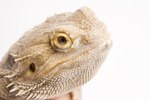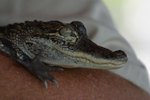
While similar in name, the bearded dragon and the water dragon require different environments to keep them happy, healthy pets. Although the enclosures the two types of animals need are quite different, they have similar needs in terms of food, lighting, heat, humidity and habitat furnishings.
Size

One major difference between owning a bearded dragon and owning a water dragon is that a bearded dragon can be housed in an aquarium and a full-grown water dragon will need an enclosure the size of a small room. An adult water dragon can grow to over 3 feet long, and his enclosure should be at three times as long and twice as wide as himself. Chinese water dragons are arboreal and so will also need height to their enclosures and objects on which to climb. Many water dragon keepers find that an outdoor enclosure used when weather is acceptable is the best home for their dragons. Because of all this, the bearded dragon is easier to house. Full-grown bearded dragons range in length from 16 to 20 inches. A 40-gallon tank is considered the minimum for a bearded dragon, with 55 gallons being preferable.
Habitat
The key difference between water dragon and bearded dragon habitats is that water dragons need two main areas in their enclosure: one terrestrial, one aquatic. The aquatic area needs to be big enough for the animal to immerse himself and swim. The humidity in a water dragon closure should be slightly greater than that for bearded dragons, who hail from an arid climate. Bearded dragons need only a shallow water bath once a week. Both dragon types need full-spectrum UV light 12 hours a day.
Temperature
Bearded and water dragons need a basking area and a cooler area to stay comfortable. Australian water dragons need a basking area between 85 and 95 degrees F, and a cool section between 68 and 77 degrees F. Chinese water dragons require a warmer minimum temperature, at 75 to 80 degrees. A basking spot of 95 degrees F for adult beardies is required, with a cool side at 85 degrees F during the day. Temperatures as low as 65 degrees F for nighttime are acceptable for beardies. Water dragons must be kept at a temperature of at least 68 degrees at all times. Keep in mind that with a much larger enclosure, water dragons require bigger, stronger heat lamps and heaters.
Feeding
Both water and bearded dragons are omnivores. Adult water dragons eat live prey, prepared reptile foods, fruits, vegetables and dietary supplements. Movement is what stimulates the water dragon to hunt, so pre-killed prey is usually not acceptable. They need to eat only about three times per week. Beardies and water dragons must always have a supply of fresh water, which should be checked regularly for cleanliness. A bearded dragon's basic diet can consist of crickets and leafy greens, supplemented with other insects and worms, vegetables, fruits, and a reptile vitamin powder once a week. Beardies can be fed once a day or every other day.
Behavior

Water dragons are social animals, but in an enclosure adult males will not tolerate each other. One will establish himself as the dominant male and the subordinate will be harrassed. Water dragons should always be kept in pairs or groups. For pairs, male/female is best and female/female is second best. Both water and bearded dragons can be trained to be friendly, docile pets. Water dragons don't take to handling naturally but can be tamed if gentle handling starts from a very early age. Bearded dragons enjoy attention from people and are often chosen as pets for children. They don't need to be kept in pairs or groups, but will tolerate each other if housed together. Their enclosure must then be larger to compensate. Beardies are non-aggressive lizards so they can be housed in any combination of sexes.
References
Resources
Photo Credits
-
BananaStock/BananaStock/Getty Images
Writer Bio
Madeline Masters works as a dog walker and professional writer. In the past she has worked as a fitness columnist, fundraising copywriter and news reporter. Masters won two Pennsylvania Newspaper Association Awards in 2009. She graduated from Elizabethtown College with a Bachelor of Arts in English.




